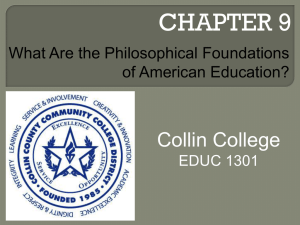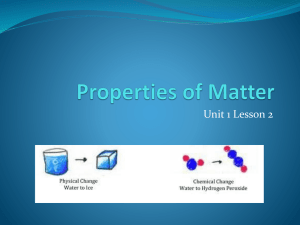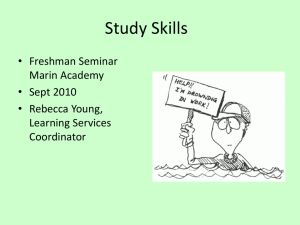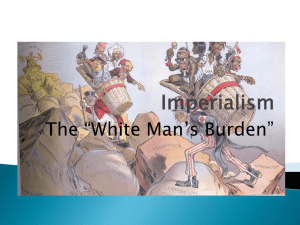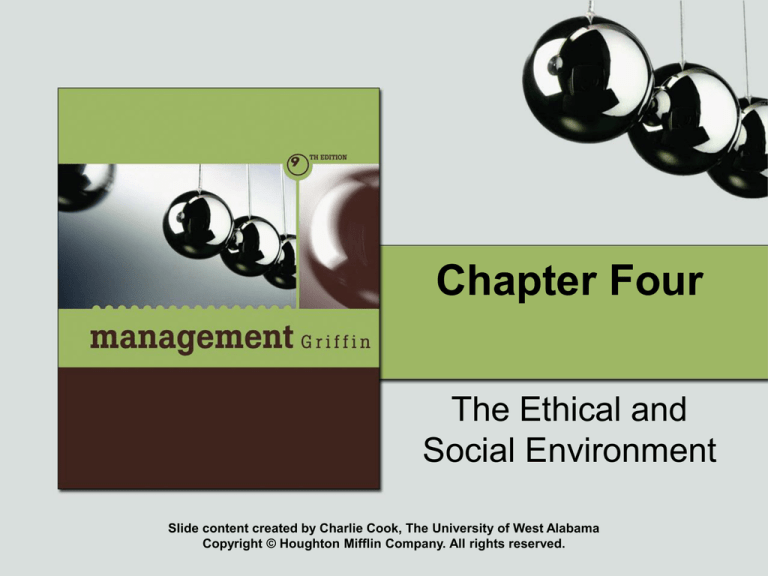
Chapter Four
The Ethical and
Social Environment
Slide content created by Charlie Cook, The University of West Alabama
Copyright © Houghton Mifflin Company. All rights reserved.
Learning Objectives
After studying this chapter, you should be able to:
1.
Discuss managerial ethics, three areas of special
ethical concern for managers, and how organizations
manage ethical behavior.
2.
Identify and summarize several emerging ethical issues
in organizations today.
3.
Discuss the concept of social responsibility, specify to
whom or what an organization might be considered
responsible, and describe four types of organizational
approaches to social responsibility.
4.
Explain the relationship between the government and
organizations regarding social responsibility.
5.
Describe some of the activities organizations may
engage in to manage social responsibility.
Copyright © Houghton Mifflin Company. All rights reserved.
4–2
Individual Ethics In
Organizations
• Ethics
– An individual’s personal beliefs regarding what is
right and wrong or good and bad.
• Ethical Behavior
– “Eye of the beholder” or behavior that conforms to
generally accepted social norms.
• Examples of Unethical Behavior
– “Borrowing” office supplies for personal use,
“Surfing the Net” on company time.
– Filing falsified or inflated business expense
reports.
Copyright © Houghton Mifflin Company. All rights reserved.
4–3
Figure 4.1: Managerial Ethics
Copyright © Houghton Mifflin Company. All rights reserved.
4–4
Ethics in Organizations
Individual Values
+
Organizational Values
=
Managerial Values
Copyright © Houghton Mifflin Company. All rights reserved.
4–5
Applying Ethical Judgments
• Model for deciding whether or not a particular
action or decision is ethical
– Gather relevant factual information.
– Determine the most appropriate moral values.
– Make a judgment.
• Ethical Norms Affecting Actions
–
–
–
–
Utility
Rights
Justice
Caring
Copyright © Houghton Mifflin Company. All rights reserved.
4–6
Figure 4.2: A
Guide for
Ethical
Decision
Making
Source: Adapted from Gerald F. Cavanagh, Dennis J. Moberg, and Manuel Velasquez, “Making Business Ethics Practical,” Business
Ethics Quarterly (July 1995); and Manuel Velasquez, Gerald F. Cavanagh, and Dennis Moberg, “Organizational Statesmenship and
Dirty Politics,” Organizational Dynamics (Autumn, 1983), p. 84. Copyright 1983, with permission from Elsevier Science. Reprinted
from Gerald F. Cavanagh, American Business Values, 4th Edition (Upper Saddle River, N.J.: Prentice-Hall, 1998). Reprinted by
permission of Prentice-Hall, Inc.
Copyright © Houghton Mifflin Company. All rights reserved.
4–7
Social Responsibility
and Organizations
• Organizational Stakeholders
– People and organizations directly affected by the
behaviors of an organization and that have a stake
in its performance.
• Social Responsibility
– The set of obligations to behave responsibly.
• Areas of Social Responsibility
– Stakeholders
– The natural environment
– The general social welfare
Copyright © Houghton Mifflin Company. All rights reserved.
4–8
Figure 4.3: Organizational
Stakeholders
Copyright © Houghton Mifflin Company. All rights reserved.
4–9
Figure 4.4: Arguments for and
Against Social Responsibility
Copyright © Houghton Mifflin Company. All rights reserved.
4–10
Figure 4.5: Approaches
to Social Responsibility
Copyright © Houghton Mifflin Company. All rights reserved.
4–11
Approaches to Social
Responsibility (cont’d)
• Obstructionist Stance
– Do as little as possible
• Defensive Stance
– Do only what is legally required and nothing more.
• Accommodative Stance
– Meet legal and ethical obligations and go beyond
that in selected cases.
• Proactive Stance
– Organization views itself as a citizen and
proactively seeks opportunities to contribute to
society.
Copyright © Houghton Mifflin Company. All rights reserved.
4–12
Figure 4.6: How Business and the
Government Influence Each Other
Copyright © Houghton Mifflin Company. All rights reserved.
4–13
Managing Social Responsibility:
Formal Organizational Dimensions
• Legal Compliance
– Extent to which the organization conforms to local,
state, federal, and international laws.
• Ethical Compliance
– Extent to which members of the organization
follow basic ethical/legal standards of behavior.
• Philanthropic Giving
– Awarding of funds or gifts to charities and other
social programs.
Copyright © Houghton Mifflin Company. All rights reserved.
4–14
Managing Social Responsibility:
Informal Organizational Dimensions
• Organization Leadership and Culture
– Leadership practices and the culture of the
organization can help define the social
responsibility stance an organization and its
members will adopt.
• Whistle Blowing
– The organizational response to the disclosure by
an employee of illegal or unethical conduct on the
part of others within the organization is indicative
of the organization’s stance on social
responsibility.
Copyright © Houghton Mifflin Company. All rights reserved.
4–15
Evaluating Social
Responsibility
• Concept of Control
– Evaluating responses to questionable legal or
ethical conduct
• Initiate an immediate follow-up response to events?
• Seek punishment for those involved?
• Engage in delay or cover-up tactics?
– Corporate Social Audit
• Analysis of the effectiveness of social performance
conducted by a task force of high-level managers from
within the firm.
• Requires the organization to clearly define its social
goals, analyze resources, determine how well goals are
being met, and make recommendations for areas
needing attention.
Copyright © Houghton Mifflin Company. All rights reserved.
4–16
Key Terms
•
•
•
•
•
•
•
•
•
•
unethical behavior
managerial ethics
code of ethics
Sarbanes-Oxley Act of
2002
social responsibility
organizational
stakeholder
obstructionist stance
defensive stance
accommodative stance
proactive stance
Copyright © Houghton Mifflin Company. All rights reserved.
•
•
•
•
•
•
•
regulation
lobbying
legal compliance
ethical compliance
philanthropic giving
whistle blowing
corporate social
audit
4–17



